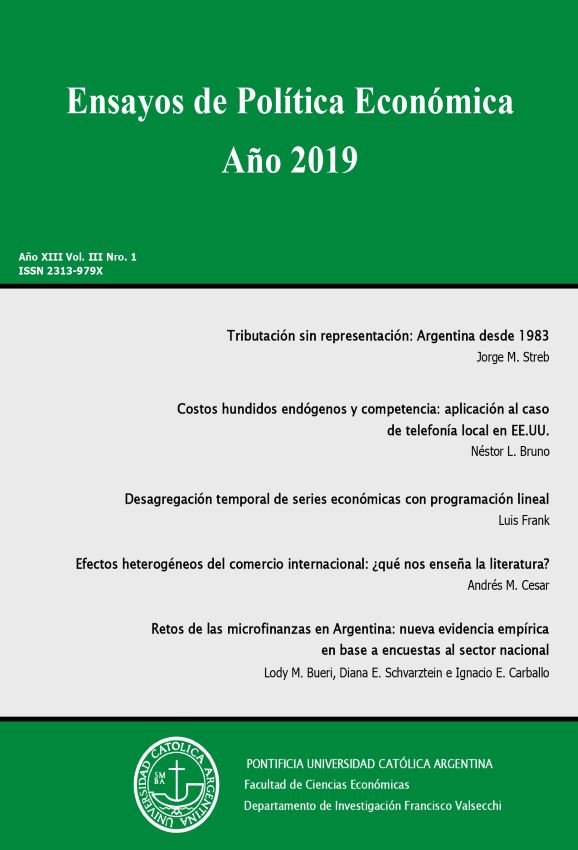Desagregación temporal de series económicas con programación lineal
Palabras clave:
desagregación temporal, interpolación, conciliación, Cuentas NacionalesResumen
El artículo presenta un método de desagregación temporal de series de tiempo, que combina la interpolación de datos de baja frecuencia con una o más series relacionadas de alta frecuencia. La serie desagregada es, esencialmente, la solución a un programa lineal que minimiza la suma de desvíos absolutos con la serie de baja frecuencia y con series relacionadas de alta frecuencia. El método es útil para conciliar series de baja frecuencia con otras relacionadas de alta frecuencia, cuando estas últimas presentan valores atípicos, datos faltantes o, incluso, cuando presentan distintas frecuencias. El nuevo método se pone a prueba desagregando la serie trimestral del VAB industrial con esta componente del Estimador Mensual de Actividad Económica.Descargas
Citas
Bee Dagum, E. y P. A. Cholette (2006). Benchmarking, Temporal Distribution, and Reconciliation Methods for Time Series. New York: Springer.
Boot, J.C.G., Feibes, W. y J.H.C. Lisman (1967). “Further methods of derivation of quarterly figures from annual data”, Applied Statistics, 16 (1), 65-75.
Camacho, M., Dal Bianco, M. y J. Martínez-Martín (2013). Short-Run Forecasting of Argentine GDP Growth. Working Paper Number 13/14. BBVA Research. Madrid. Disponible online en: https://www.bbvaresearch.com
Chow, G.C. y A.L. Lin (1971). “Best linear unbiased interpolation, distribution and extrapolation of time series by related series”. The Review of Economics and Statistics, 53, 372-375.
Denton, F.T. (1971). “Adjustment of monthly or quarterly series to annual totals: An approach based on quadratic minimization”. Journal of the American Statistical Association, 66 (333), 99-102.
Fernández, R. B. (1981). “A methodological note on the estimation of time series”. The Review of Economics and Statistics, 63 (3), 471-476.
Martín Lucero, L. E. (2001). Reseña: Índice de Producción Industrial y sus ciclos. Documento de Trabajo Nro. 70. Fundación de Investigaciones Económicas Latinoamericanas (FIEL).
International Monetary Fund. Statistics Department (2018). Quarterly National Accounts Manual 2017 Edition. Washington, DC. Disponible on-line en: https://www.imf.org/external/pubs/ft/qna/
Greene W. (2008). Econometric Analysis. New Jersey: Pearson-Prentice Hall.
Instituto Nacional de Estadística y Censos (INDEC) (1997). Censo Nacional Económico 1994. Resultados definitivos, versión revisada. Total del país: industria, comercio, servicios, petróleo y gas, otras explotaciones mineras, intermediación financiera. (Serie A). Buenos Aires.
Instituto Nacional de Estadística y Censos (INDEC) (2006). Estimador Mensual Industrial (EMI), Año base 2004=100. Anexo metodológico. Buenos Aires. ISSN 0327-7968. Disponible on-line en: https://www.indec.gob.ar/
Instituto Nacional de Estadística y Censos (INDEC) (2016). Estimador Mensual de Actividad Económica, EMAE: base año 2004. Metodología INDEC nro. 20. Primera edición. Ciudad Autónoma de Buenos Aires. 12 p. Disponible on-line en: https://www.indec.gob.ar/
Infante, E. (2017). Two-Step Reconciliation of Time Series. New Formulation and Validation. Tesis. Universitá degli Studi di Napoli. Dipartimento di Scienze Economiche e Statistiche. 198 p. Disponible en: http://www.fedoa.unina.it/11731/
Jacobs J., Kroonenberg S. y T. Wansbee (1992). Dividing by 4. An eficient algorithm for the optimal disaggregation of annual data into quarterly data. Disponible on-line en:
http://www.eco.rug.nl/medewerk/JACOBS/jjdownload/graytex.pdf
Jarque, C y Bera, A. (1987). “A test for normality of observations and regression residuals”, International Statistical Review, 55,163-172.
Lütkepohl, H. (2007) New Introduction to Multiple Time Series Analysis. Heidelberg: Springer-Verlag.
Mitchell, J. y M. Weale (2005a). Estimates of monthly GDP for the Euro area: an application of the regression approach to interpolation. Working Papers and Studies. Luxembourg: Office for Official Publications of the European Communities. ISSN 1725-4825. ISBN 92-79-01307-6.
Mitchell, J. y M. Weale (2005b). “An Indicator of Monthly GDP and an Early Estimate of Quarterly GDP Growth”, The Economic Journal, 115 (501),F108-F129.
Toutenburg H. y Shalabh (2009). Statistical Analysis of Designed Experiments., New York: Springer.
Williams, H.P. (2013). Model Building in Mathematical Programming,. West Sussex: John Wiley & Sons Ltd
Descargas
Publicado
Cómo citar
Número
Sección
Licencia








